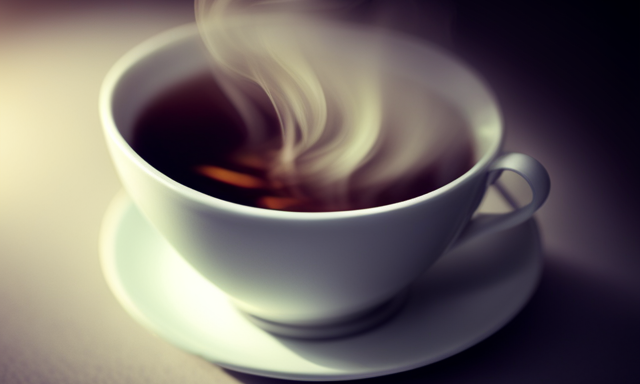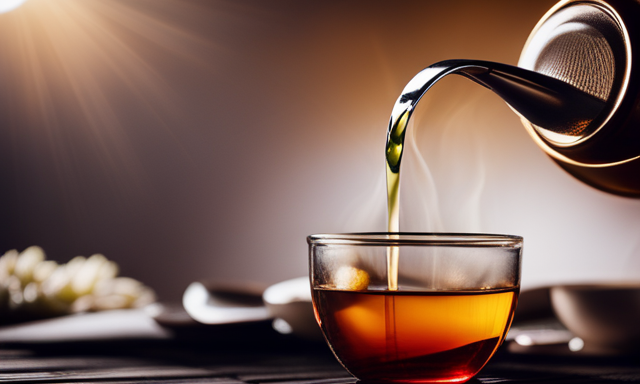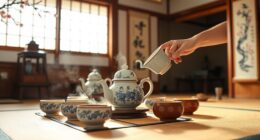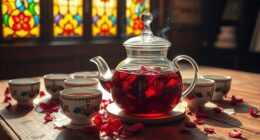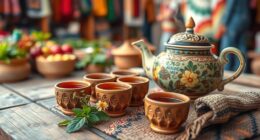Have you ever wondered how long your oolong tea will stay fresh and flavorful? Well, I’m here to shed some light on this topic and provide you with all the information you need.
Oolong tea is a beloved beverage known for its unique taste and health benefits. But like any other tea, it has a shelf life. The question is, how long does oolong tea keep?
In this article, we will explore the factors that affect the longevity of oolong tea, proper storage techniques, signs of tea going bad, and ways to extend its freshness. We will also compare the shelf life of oolong tea with other tea varieties.
So, grab a cup of oolong tea and get ready to dive into the world of tea storage.
Key Takeaways
- Storing oolong tea properly is important to maintain its freshness and flavor.
- Checking the appearance and aroma of oolong tea before consuming it is essential.
- Spoiled oolong tea can be detected through its smell, color, and the presence of mold.
- Refrigeration is not recommended for storing oolong tea due to temperature fluctuations.
Understanding the Shelf Life of Oolong Tea
Understanding the shelf life of oolong tea is crucial for preserving its quality. Oolong tea is a delicate beverage that can easily lose its flavor and aroma if exposed to air, light, heat, or moisture. To extend its shelf life, it is important to store oolong tea in an airtight container, away from direct sunlight, at a cool and dry place.
Keeping it away from strong odors is essential to prevent flavor contamination. Properly stored oolong tea can maintain its freshness and taste for an extended period. However, various factors, such as the quality of the tea leaves, processing methods, and storage conditions, can affect the longevity of oolong tea.
Now let’s explore these factors that contribute to the shelf life of oolong tea.
Factors That Affect the Longevity of Oolong Tea
When you savor a cup of this delightful brew, you’ll be amazed at how various factors can influence the lifespan of your beloved oolong.
One key factor is the understanding of the oxidation process. Oolong tea is partially oxidized, which means it undergoes a controlled level of exposure to air. The degree of oxidation directly affects the tea’s flavor and shelf life.
Additionally, the impact of packaging material is crucial. Oolong tea should be stored in airtight containers to minimize its exposure to air and moisture. The type of packaging material used, such as tin cans or vacuum-sealed bags, can significantly prolong the tea’s freshness.
Understanding the oxidation process and choosing the right packaging material are essential for extending the longevity of oolong tea. Proper storage ensures that you can continue enjoying the exquisite taste and aroma of this tea for longer periods.
Now, let’s delve into the art of storing oolong tea properly.
Storing Oolong Tea Properly
When it comes to storing oolong tea properly, there are a few key points to keep in mind.
First, it’s important to use airtight containers to protect the tea from exposure to air, which can cause it to lose its flavor and potency.
Second, it’s crucial to avoid exposing the tea to moisture, as this can lead to mold and other issues.
Lastly, it’s essential to keep the tea away from light and heat, as these factors can also degrade its quality.
Using Airtight Containers
To keep your oolong tea fresh for a longer period of time, make sure you store it in airtight containers. Using glass containers is a great option because they are non-reactive and won’t affect the flavor of the tea. However, there are alternative storage methods you can consider, such as stainless steel containers or ceramic jars with tight-fitting lids. These options also provide airtight seals to prevent air from entering and compromising the quality of your tea.
Avoiding exposure to moisture, light, and heat is crucial in maintaining the freshness of your oolong tea. Moisture can lead to mold or spoilage, while light and heat can degrade the flavor and aroma. By storing your tea in airtight containers, you can protect it from these elements and ensure its longevity.
Avoiding Exposure to Moisture, Light, and Heat
By storing your oolong tea in airtight containers, you can shield it from the damaging effects of moisture, light, and heat. This is crucial for preventing oxidation and maintaining the tea’s quality and flavor.
When exposed to moisture, oolong tea can become damp and develop mold or mildew, which affects its taste and aroma. Likewise, exposure to light can cause the tea leaves to deteriorate, resulting in a loss of flavor and color. Heat is another enemy of oolong tea, as it can accelerate the oxidation process and lead to a stale taste.
To combat these issues, it is essential to use the best storage containers that are airtight, opaque, and made of materials such as glass or ceramic that do not absorb or release odors. Proper storage will help preserve the freshness and longevity of your oolong tea, ensuring a delightful drinking experience.
Moving on to the signs of oolong tea going bad…
Signs of Oolong Tea Going Bad
If you notice any strange odors or mold growing on your oolong tea, it’s time to throw it away. Stale oolong tea can be revived by following a few simple steps.
The best way to store oolong tea is in an airtight container that is kept away from moisture, light, and heat. This will help to maintain its freshness and prevent it from going bad. However, even with proper storage, oolong tea can still go bad over time.
Signs of oolong tea going bad include a musty or sour smell, visible mold growth, or a change in color or taste. If you notice any of these signs, it is best to discard the tea and brew a fresh batch.
In the next section, we will explore ways to extend the freshness of oolong tea without compromising its quality.
Extending the Freshness of Oolong Tea
Preserving the delightful taste and aroma of oolong tea for longer is essential for tea enthusiasts. To extend the shelf life and preserve the flavor profile of oolong tea, there are a few key steps to follow.
-
Store in airtight containers: Oolong tea should be stored in airtight containers to prevent exposure to air, moisture, and light, which can degrade its quality.
-
Keep away from strong odors: Oolong tea easily absorbs odors, so it is important to store it away from strong-smelling substances.
-
Store in a cool, dark place: Oolong tea should be stored in a cool, dark place to maintain its freshness and prevent it from spoiling.
By following these measures, tea enthusiasts can ensure that their oolong tea stays fresh and delicious for a longer period.
Now, let’s explore how to brew oolong tea for optimal flavor.
Brewing Oolong Tea for Optimal Flavor
Brewing oolong tea for optimal flavor requires careful attention to specific techniques. The flavor of oolong tea can vary greatly depending on factors such as the type of oolong, water temperature, steeping time, and the number of infusions. To bring out the best taste, it is recommended to use water that is around 190-205°F and steep the tea leaves for 3-5 minutes. This will allow the delicate flavors to bloom without becoming too bitter or astringent. By mastering the right brewing techniques, you can fully appreciate the complex aromas and flavors that oolong tea has to offer.
Now, let’s explore how oolong tea compares to other tea varieties in terms of shelf life.
Oolong Tea vs. Other Tea Varieties in Terms of Shelf Life
To maintain the freshness of other tea varieties, you need to store them in airtight containers away from moisture and sunlight.
When it comes to oolong tea, it stands out from other tea varieties in terms of shelf life. Due to its semi-fermented nature, oolong tea can be stored for longer periods without losing its flavor and aroma.
The unique combination of oxidation and withering during the production process gives oolong tea a complex flavor profile, ranging from fruity and floral to woody and toasty. This makes it highly sought after by tea enthusiasts.
Oolong tea also offers numerous health benefits, including boosting metabolism, aiding in weight loss, and promoting heart health.
Now that we understand the exceptional shelf life and flavor profiles of oolong tea, let’s explore the common mistakes to avoid when storing it.
Common Mistakes to Avoid When Storing Oolong Tea
Proper storage is crucial to maintain the freshness and flavors of oolong tea. One common mistake is leaving the tea exposed to air, light, or moisture. These elements can degrade its quality. Instead, store your oolong tea in an airtight container, away from direct sunlight and humidity.
Another mistake to avoid is storing oolong tea near strong-smelling items. It can absorb odors and alter its taste. By being mindful of these common mistakes, you can ensure that your oolong tea remains at its best.
Now let’s delve into frequently asked questions about oolong tea storage.
Frequently Asked Questions About Oolong Tea Storage
Can I drink oolong tea past its expiration date?
The expiration date on oolong tea is a guideline for optimal freshness and flavor. While it is generally safe to consume oolong tea past its expiration date, the taste and quality may deteriorate over time. It is recommended to always check the appearance and aroma of the tea before consuming it.
How can I tell if my oolong tea has gone bad?
Signs that oolong tea has gone bad include a stale or musty odor, a change in color, or the presence of mold. If the tea smells off or looks different than usual, it is best to discard it to avoid any potential health risks.
Can I store oolong tea in the refrigerator?
Oolong tea can be stored in the refrigerator, but it is important to keep it in an airtight container to prevent absorption of odors from other foods. Additionally, moisture can affect the flavor and quality of the tea, so it is recommended to use a moisture-proof storage container or bag.
Can I drink oolong tea past its expiration date?
If you find a forgotten pack of oolong tea in the back of your pantry, go ahead and brew a cup even if it’s past its expiration date. Drinking expired oolong tea does not pose significant health risks. While the flavor and aroma may have deteriorated over time, it is generally safe to consume.
However, it is important to note that the taste and quality may not be as good as when it was fresh. To ensure the tea is still good to drink, check for any signs of spoilage such as an off smell, mold, or unusual color. If your oolong tea has gone bad, it is best to discard it.
Moving on to the next section, how can I tell if my oolong tea has gone bad?
How can I tell if my oolong tea has gone bad?
One interesting statistic to note is that oolong tea can retain its freshness and flavor for up to two years if stored properly. When it comes to detecting spoiled oolong tea, there are a few key indicators to look out for. Firstly, check for any unusual odors or off smells. If your oolong tea has a musty or rancid scent, it’s likely gone bad. Additionally, inspect the leaves for any signs of mold or discoloration. Spoiled oolong tea may have a slimy texture or appear discolored. To ensure the longevity of your oolong tea, it’s vital to store it correctly. The best way to store oolong tea is in an airtight container, away from moisture, light, and strong odors. By following these guidelines, you can enjoy fresh and flavorful oolong tea for an extended period. Now, let’s explore whether you can store oolong tea in the refrigerator.
Can I store oolong tea in the refrigerator?
When determining if my oolong tea has spoiled, it is crucial to consider proper storage methods. Now, let’s talk about storing oolong tea in the refrigerator.
While refrigeration may seem like a good idea, it is not recommended for oolong tea. The fluctuating temperatures inside the fridge can negatively impact the tea’s freshness, altering its flavor and aroma.
Instead, it is best to store oolong tea in a cool environment away from direct sunlight, moisture, and strong odors. This will help maintain its quality and extend its shelf life.
To summarize, refrigeration is not suitable for oolong tea storage due to the temperature fluctuations.
Now, let’s move on to some final thoughts and tips for enjoying fresh oolong tea.
Final Thoughts and Tips for Enjoying Fresh Oolong Tea
To fully savor the delightful taste and aroma of fresh oolong tea, you’ll want to make sure to store it properly and drink it within a reasonable timeframe. Proper storage is essential to maintain the quality of oolong tea. Here are some final thoughts and tips for enjoying fresh oolong tea:
-
Store it in an airtight container: This will prevent moisture and air from degrading the tea’s flavor.
-
Keep it away from strong odors: Oolong tea can absorb odors easily, so store it away from spices, coffee, or any other strong-smelling substances.
-
Drink it within 6-12 months: Oolong tea is best enjoyed when it’s fresh. After this time, the flavor may start to deteriorate.
By following these tips, you can ensure that your oolong tea stays fresh and delicious. Additionally, oolong tea offers various health benefits, such as improving heart health, boosting metabolism, and aiding in weight management. So, not only does oolong tea taste great, but it also contributes to your overall well-being.
Frequently Asked Questions
Can I store oolong tea in the refrigerator to extend its shelf life?
Storing oolong tea in the refrigerator can slightly extend its shelf life, but be cautious! The cold temperature can alter the flavor, resulting in a less enjoyable cup. Consider alternative methods like airtight containers and cool, dark storage to preserve freshness.
How long does oolong tea typically stay fresh after opening the package?
Oolong tea typically stays fresh for about 6 to 12 months after opening the package if stored properly. To ensure freshness, store it in an airtight container away from light, heat, and moisture. Signs of oolong tea going bad include loss of aroma and flavor.
Does the quality of oolong tea affect its shelf life?
The processing method of oolong tea greatly impacts its shelf life. Loose leaf form tends to retain freshness longer than tea bags due to less exposure to air and moisture.
Can I use expired oolong tea for other purposes, such as cooking or skincare?
I can use expired oolong tea for other purposes like cooking or skincare. The benefits of oolong tea for skincare include reducing inflammation and promoting healthy skin due to its antioxidants and polyphenols.
Are there any specific storage containers or materials that are recommended for oolong tea?
I recommend storing oolong tea in airtight storage containers made of materials like glass or ceramic. These containers help maintain the tea’s freshness and prevent moisture or odors from affecting its flavor.
Conclusion
In conclusion, taking proper care of your oolong tea is crucial in ensuring its freshness and longevity. By understanding the shelf life of oolong tea and the factors that affect it, you can make informed decisions about storage.
Remember to store oolong tea in an airtight container, away from light, heat, and moisture. Keep an eye out for signs of tea going bad, such as a stale or musty smell.
By avoiding common mistakes and following these guidelines, you can savor the exquisite flavors of oolong tea for an extended period. As the saying goes, "A well-preserved cup of oolong tea is a journey to the depths of flavor."

